wg48temp9
National Hazard
   
Posts: 761
Registered: 30-12-2018
Location: not so United Kingdom
Member Is Offline
|
|
Oil lock up of rotary vane vacuum pumps
My vacuum pump is a Pfeiffer DUO 2.5 dual stage it frequently will not start. After struggling with it. I suddenly remembered an old belt driven
vacuum pump I previously had with the same problem. With that belt driven pump you could feel it was locked (more accurately very difficult to turn)
by attempting to rotate the pulley by hand.
Apparently what happens is after the pump has pulled a vacuum and is then turned off, at certain points in its rotation the vacuum left in the pump
sucks in the oil filling the one of pump chambers. When the pump is started up next time the incompressible oil prevents the the pump from
rotating.
With the pulley driven pump it was possible to force the pulley round slowly by hand after abut one turn it would turn relatively easily and would
start ok electrically.
My Pfeiffer pump is direct drive so that is not possible. I suspect its so worn the oil fills up the vacuum chamber in only an hour or two. It was a
used laboratory pump and bought on ebay some time ago so no chance of sending it back. Time to strip it down and see how worn it is. Perhaps I will
use it as a roughing pump and buy a new one.
On a different trouble shooting problem. I just spent two hours repairing an outside lamp. It seemed to have a short between the neutral and earth in
the wiring. but when I came to connect the new wire up in the distribution box I notices the neutral had been connected to the wrong neutral bar the
one before the RCD. Apparently the house owner had a new electrical heater fitted recently and I suspect the wire became loose and was reconnected
to the wrong bar and the next time the outside light was switched on the RCD tripped turning off most of the house.
Of cause I had asked the home owner if anyone had been fiddling with the wires for the light and was assured that it had worked fine for 15 years and
that no one had fiddled with the wires.
PS: sometimes homeowners or their friends fiddle with stuff and screw it up but then do not own up.
I am wg48 but not on my usual pc hence the temp handle.
Thank goodness for Fleming and the fungi.
Old codger' lives matters, wear a mask and help save them.
Be aware of demagoguery, keep your frontal lobes fully engaged.
I don't know who invented mRNA vaccines but they should get a fancy medal and I hope they made a shed load of money from it.
|
|
|
Heavy Walter
Hazard to Others
  
Posts: 127
Registered: 17-12-2015
Location: Argentina
Member Is Offline
Mood: No Mood
|
|
Hi
In my lab I have three Pfeiffer pumps. No one shown that problem, ever.
Do a maintenance on it.
|
|
|
Fyndium
International Hazard
    
Posts: 1192
Registered: 12-7-2020
Location: Not in USA
Member Is Offline
|
|
I had a similar problem with my pump. It jammed at certain position, and sometimes little tapping or repeated restarting fixed the issue, but once I
had to open the oil reservoir and turn the pump a little by hand to make it work again.
Haven't had this since though when I opened up the pump, cleaned it and reassembled with fresh oil.
|
|
|
Bezaleel
Hazard to Others
  
Posts: 444
Registered: 28-2-2009
Member Is Offline
Mood: transitional
|
|
Old oil in pumps is one issue. (It also tends to form a sticky carbonaceous layer on the main hub.)
Another is to open the gas ballast before switching off the pump. Though not its primary function, this allows air to flow in slowly, so that the
vacuum in the second chamber is removed, which prevents oil from being pressed in. You can hear it hiss or shriek when it sucks in air through the
ballast tube. Note that with some pumps it takes a little while before the oil in the gas ballast tube is sucked out, and the air is allowed to flow
in. You can tell when hissing starts.
I once had a (custom made) gearwheel replaced which was very expensive. The old one broke exactly because of this issue. (I learned by doing, as
often.) Ever since, I always make the first rotation by hand before I switch on the pump. If it goes with difficulty, I know I didn't switch it off
properly. It may well be that there are pumps that have a mechanism in place to prevent the issue, but mine hasn't . It pulls a decent vacuum though,
to around 10 Pa.
|
|
|
wg48temp9
National Hazard
   
Posts: 761
Registered: 30-12-2018
Location: not so United Kingdom
Member Is Offline
|
|
Quote: Originally posted by Bezaleel  | Old oil in pumps is one issue. (It also tends to form a sticky carbonaceous layer on the main hub.)
Another is to open the gas ballast before switching off the pump. Though not its primary function, this allows air to flow in slowly, so that the
vacuum in the second chamber is removed, which prevents oil from being pressed in. You can hear it hiss or shriek when it sucks in air through the
ballast tube. Note that with some pumps it takes a little while before the oil in the gas ballast tube is sucked out, and the air is allowed to flow
in. You can tell when hissing starts.
|
Thanks Bezalee. I tried the opening the ballast trick before turn off three times and with upto a ten minute wait, the pump start ok. Without opening
the ballast it locked up three times.
An other problem is when the pump is cold (about 10C) if it starts it runs very slowly so I suspect its gummed up or the oil is too viscous. When I
strip the pump down I will replace the oil with a recommended type or equivalent.
I estimate the achieved vacuum is about 0.15 to 0.1mmHg from the appearance of an electrical discharge between two steel rods in a 500mL three
necked flask. That pressure needs to be about ten times lower for the diffusion pump. Hopefully I will get there with a clean pump, fresh oil and
better connections with less plastic tubing.
[Edited on 10/19/2020 by wg48temp9]
I am wg48 but not on my usual pc hence the temp handle.
Thank goodness for Fleming and the fungi.
Old codger' lives matters, wear a mask and help save them.
Be aware of demagoguery, keep your frontal lobes fully engaged.
I don't know who invented mRNA vaccines but they should get a fancy medal and I hope they made a shed load of money from it.
|
|
|
Heptylene
Hazard to Others
  
Posts: 319
Registered: 22-10-2016
Member Is Offline
Mood: No Mood
|
|
Hmm, I wish I had known about this issue a few months ago.
I recently acquired a Leybold D10E rotary vane pump from ebay which the seller said had been tested and was working fine. So when I got it I turned it
on briefly and it wouldn't do anything except a loud humming (motor not turning). I thought there was something broken inside and the seller had
ripped me off. I ended up taking the pump fully apart but didn't find any major issue. Now I'm pretty sure it was locked for the same reason as yours
wg48.
Btw, I've heard of oil suckback occuring and filling whatever chamber is being evacuated, which must be a real pain. For this reason I always vent the
vacuum line before turning the pump off.
I've actually taken my pump apart a second time to change some worn parts (vanes, valve flaps and springs) so I have a few bits of advice so you don't
make the same mistakes I did:
- Cover your workbench with 2 layers of cardboard to absorb the oil which will inevitably leak out. Draining the oil beforehand will not suffice, i
had about 50 ml left inside even after that.
- Use gloves.
- Remove the motor from the pump's body, it makes handling easier.
- Put the parts in baggies so you don't lose them. I grouped them by general location within the pump.
- Have a lot of paper towels available. I used almost a roll each time.
|
|
|
wg48temp9
National Hazard
   
Posts: 761
Registered: 30-12-2018
Location: not so United Kingdom
Member Is Offline
|
|
Heptylene: Thanks for the good advice. I have taken all kinds of oil filled machines apart ranging from car gearboxes, pressure washers, fridge
compressors and an old belt driven vacuum pump. But its useful to be reminded. Do you only use your pump for distillations ?
The end plates on the rotor housing of that old vacuum pump were so worn you could feel the edge. I contemplated lapping them flat again but never got
round to it. Hopefully this pump is in better condition.
I am feeling more confident with it as I have fixed a leak on my lashed up discharge tube (a flask with three necks for two thermometer holders for
electrodes and one for the hose connection) I estimated its down to about 0.01mm Hg from the discharge appearance: almost a dark discharge with a
whitish fluorescence on the glass. I also checked it was the glass glowing with magnet as its hard the judge if its a diffuse discharge or glass
fluorescence. I also added a piece of glass coated with phosphor from a broken fluorescent tube. It only glowed in the almost dark discharge.
I used three MOTs in series one powered and the other's HT windings as a ballast.

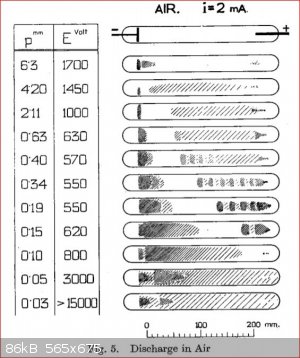
I will take some pics eventually
PS: My pump has an automatic shut of valve on the inlet to stop suck back but its still recommended not to leave it under vacuum for any significant
time.
[Edited on 10/19/2020 by wg48temp9]
I am wg48 but not on my usual pc hence the temp handle.
Thank goodness for Fleming and the fungi.
Old codger' lives matters, wear a mask and help save them.
Be aware of demagoguery, keep your frontal lobes fully engaged.
I don't know who invented mRNA vaccines but they should get a fancy medal and I hope they made a shed load of money from it.
|
|
|
Heptylene
Hazard to Others
  
Posts: 319
Registered: 22-10-2016
Member Is Offline
Mood: No Mood
|
|
Glad to know oil-filled machinery is not an issue  For me it was a first. For me it was a first.
I don't use the pump for distillations as I don't have a cold trap. Liquid nitrogen is too expensive and doesn't last long enough to justify the
expense. Maybe if I had a specific need once I might go through the trouble.
I'm using it for some electron beam experiments so I need a vacuum of a few microns, ideally less. Turbomolecular pumps are expensive, diffusion pumps
are slow, so I'm using the mechanical pump on its own. According to my pirani gauge, it pulls down to 6e-3 mbar (= 4.5 microns) and it can almost
completely extinguish a discharge. In another experiment I managed to produce x-rays, which confirms high velocity electrons are present and that
their mean free path is large enough. I don't want to contaminate the oil with solvents so I'll have to resist the temptation, no matter how great, to
use it for chemistry purposes!
Looking forward to seeing pictures!
|
|
|
wg48temp9
National Hazard
   
Posts: 761
Registered: 30-12-2018
Location: not so United Kingdom
Member Is Offline
|
|
I recently won four faulty vacuum sensor heads.
Inficon BPG40X Bayard-Alpert Pirani combination gauge. They may of some Iridium filaments in them, only a few tens of miro grams unfortunately (0.1mm
wire). Probably not enough metal to explore its colorful chemistry
Hopefully I can get one (just the Pirani part for now) going by replacing what I assume is broken filament with a tungsten light bulb filament. I
will use a load cell amplifier HX711 with it. The HX71 has 24bit ADC which should be more than sufficient sensitivity. For 130C increase in
temperature the resistance of tungsten increases by about 60%.
Attached is a pic of one of the sensor heads looking in to the FK25 flange. I think I can see a piece of the Iridium filament (hopefully)
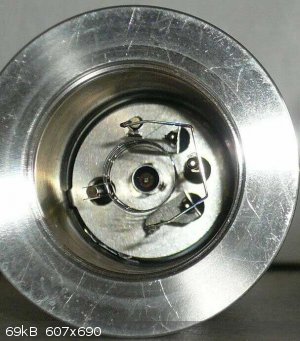
[Edited on 10/26/2020 by wg48temp9]
I am wg48 but not on my usual pc hence the temp handle.
Thank goodness for Fleming and the fungi.
Old codger' lives matters, wear a mask and help save them.
Be aware of demagoguery, keep your frontal lobes fully engaged.
I don't know who invented mRNA vaccines but they should get a fancy medal and I hope they made a shed load of money from it.
|
|
|
wg48temp9
National Hazard
   
Posts: 761
Registered: 30-12-2018
Location: not so United Kingdom
Member Is Offline
|
|
Below are some pics of an 8mm x 100mm discharge tube operating at different air pressures. Its driven from a 2,000V smoothed DC supply via an 82K
ohms. The smoothed DC supply and series resistance produces a stable discharge.
I estimate the top pic is at about 35mbar followed about 10mbar then about 3mbar. The last two pics show the Crooks dark space. The length of which is
inversely proportional to the pressure. Thats just before the discharge goes dark. You can just about see the green fluorescence of the glass near the
cathode. It was difficult to take the pics. I had to switch off most of the auto function of the camera.

and below is diagram designating the different parts of the discharge
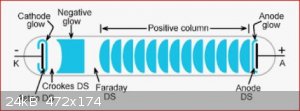
and a pic of the discharge tube taken accidentally with the flash on.

[Edited on 11/13/2020 by wg48temp9]
I am wg48 but not on my usual pc hence the temp handle.
Thank goodness for Fleming and the fungi.
Old codger' lives matters, wear a mask and help save them.
Be aware of demagoguery, keep your frontal lobes fully engaged.
I don't know who invented mRNA vaccines but they should get a fancy medal and I hope they made a shed load of money from it.
|
|
|
wg48temp9
National Hazard
   
Posts: 761
Registered: 30-12-2018
Location: not so United Kingdom
Member Is Offline
|
|
I recently bid low on five untested vacuum pumps hoping I might get one of them cheap. Wow I won all five !!!. One Javac 2 stage pump about 5m^3/h,
two Yellow jacket 2 stage pumps, a unknow make looks like a two stage pump and one Bosck RG4.0 refrigerant Recovery Unit which I assumed was a
vacuum pump.
The Javac has a crudy inlet and outlet port. The site glass has deposits on it. The motor does turn when powered. I drained the oil and started to
dismantle the pump. The oil looks like a colorless synthetic oil but its cloudy. There was some water in the sump with what looks like brownish water
emulsion. The components of the pump above the oil line are heavily rusted but below what was the oil line looks almost OK. I removed the end plate of
the final stage. No internal corrosion and no detectable wear on the end plate by that stage's rotor.
Interestingly the connection between the first stage and the final stage has an outlet like the final stage. both have one way flapper valves. I
assume this intermediate valve helps reduce oil lock up.
I checked out one of the Yellow Jacket pumps. Clean inlet, outlet and site glass. It also runs when powered and on a mechanical vacuum gauge with a
45mm diameter dial almost instantly goes to 30in hg. Worryingly the pump is very noisy hopefully thats just its all metal flapper valve
So I think my gamble has probably payed off and I may get to fix my car's AC too LOL.
I had a quick look at Bosck RG4.0 refrigerant Recovery Unit, its got a heat exchanger at one end but I can not see the vacuum pump though now I
think it only contains a compressor.
I will take some pics of strip downs and repairs and post them later.
Below is a pic of a RG4.0 recovery unit.
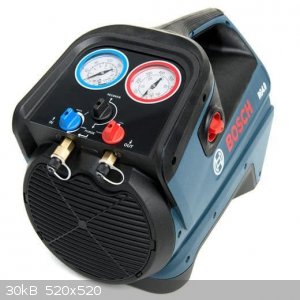
I am wg48 but not on my usual pc hence the temp handle.
Thank goodness for Fleming and the fungi.
Old codger' lives matters, wear a mask and help save them.
Be aware of demagoguery, keep your frontal lobes fully engaged.
I don't know who invented mRNA vaccines but they should get a fancy medal and I hope they made a shed load of money from it.
|
|
|
wg48temp9
National Hazard
   
Posts: 761
Registered: 30-12-2018
Location: not so United Kingdom
Member Is Offline
|
|
Below is a snip of a Harbor Freight two stage vacuum pump. Like my two stage Javac vacuum pump it has two flapper valves one on the output of the
last stage and one on the connection between the output of the first stage which also goes the the input of the last stage. I don't remember seeing
two flapper valves on the other two dual stage pumps I have looked at.
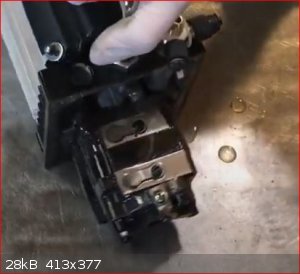
From https://www.youtube.com/watch?v=RHxiHJyZVRg
Below is a better snip
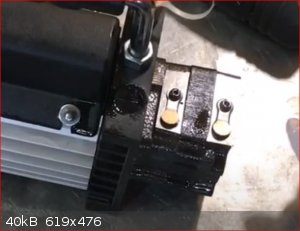
[Edited on 7/10/2021 by wg48temp9]
PS I was watched the above video because on the vanes of the last stage of my Javac are not separated by springs but on this Harbor pump the final
stage does have springs so perhaps I lost mine.
However I found the following comment on the above video which claims the spring are not required.
"You should have removed the little crappy springs from the vanes. They are not needed and they will break apart, the shrapnel will get caught between
the rotor and housing and seize up the pump. This is what happened to me, but I was lucky enough to be there to turn the motor off before the stator
burned up. I took mine apart and removed about 5 or 6 pieces of the spring that was left; including the piece that was jammed between the rotor and
housing (put a nice indentation in the metal). I put it back together without the springs and it pulls the same as it did before. It turns out that
the centrifugal force causes the vanes to hug the wall tightly, sealing the pump without needing the springs. If I bought one new, the first thing I'd
do is remove those crappy springs that will most definitely fail."
So perhaps my pump had no springs and they did not spring away as I removed the cylinder.
[Edited on 7/10/2021 by wg48temp9]
I am wg48 but not on my usual pc hence the temp handle.
Thank goodness for Fleming and the fungi.
Old codger' lives matters, wear a mask and help save them.
Be aware of demagoguery, keep your frontal lobes fully engaged.
I don't know who invented mRNA vaccines but they should get a fancy medal and I hope they made a shed load of money from it.
|
|
|
BromicAcid
International Hazard
    
Posts: 3227
Registered: 13-7-2003
Location: Wisconsin
Member Is Offline
Mood: Rock n' Roll
|
|
At one time I worked in a group making primarily isocyanates and chloroformates from phosgene. After the reaction the solvent (and hydrogen chloride
by-product) were stripped under vacuum. We used Welch belt-driven oil pumps. Let's just say they took a beating. They essentially had to be kick
started, you'd put a pipe wrench on the fly wheel and stomp on it to get it moving but once it was going they would still pull down to a mm of mercury
despite the abuse. To be clear the oil was changed after every run, traps were inline and we did power flushes but they ended up eating a lot of HCl.
It was just amazing to me the abuse they could take.
|
|
|
wg48temp9
National Hazard
   
Posts: 761
Registered: 30-12-2018
Location: not so United Kingdom
Member Is Offline
|
|
Quote: Originally posted by BromicAcid  | | At one time I worked in a group making primarily isocyanates and chloroformates from phosgene. After the reaction the solvent (and hydrogen chloride
by-product) were stripped under vacuum. We used Welch belt-driven oil pumps. Let's just say they took a beating. They essentially had to be kick
started, you'd put a pipe wrench on the fly wheel and stomp on it to get it moving but once it was going they would still pull down to a mm of mercury
despite the abuse. To be clear the oil was changed after every run, traps were inline and we did power flushes but they ended up eating a lot of HCl.
It was just amazing to me the abuse they could take. |
I had a belt driven Welch pump once. It was a well used single stage pump that would lock up, but once it was running it could get down the about a
few mms of hg if I degassed the oil first.
I will keep one of my pumps for vacuum distillations so I expect it will get abused. I will try to keep most acid vapors out of it with a soda lime
trap. I suspect the seals will not last long if subject to solvent vapors.
I am wg48 but not on my usual pc hence the temp handle.
Thank goodness for Fleming and the fungi.
Old codger' lives matters, wear a mask and help save them.
Be aware of demagoguery, keep your frontal lobes fully engaged.
I don't know who invented mRNA vaccines but they should get a fancy medal and I hope they made a shed load of money from it.
|
|
|
Texium
Administrator
       
Posts: 4508
Registered: 11-1-2014
Location: Salt Lake City
Member Is Offline
Mood: PhD candidate!
|
|
I have a freshly rebuilt Welch belt-driven pump under my hood at work that gets down to a respectable 3 mmHg. I mainly use it for evacuating reaction
flasks, but I have a cold trap set up for when I need to use it to pull solvent off. We have another larger belt driven pump for removing the last
traces of solvents that pulls down to 0.2 mmHg.
|
|
|
Bezaleel
Hazard to Others
  
Posts: 444
Registered: 28-2-2009
Member Is Offline
Mood: transitional
|
|
Quote: Originally posted by wg48temp9  | Below are some pics of an 8mm x 100mm discharge tube operating at different air pressures. Its driven from a 2,000V smoothed DC supply via an 82K
ohms. The smoothed DC supply and series resistance produces a stable discharge.
I estimate the top pic is at about 35mbar followed about 10mbar then about 3mbar. The last two pics show the Crooks dark space. The length of which is
inversely proportional to the pressure. Thats just before the discharge goes dark. You can just about see the green fluorescence of the glass near the
cathode. It was difficult to take the pics. I had to switch off most of the auto function of the camera.
and below is diagram designating the different parts of the discharge
and a pic of the discharge tube taken accidentally with the flash on.
[Edited on 11/13/2020 by wg48temp9] |
Thanks for posting this! I was not aware that these discharge phenomena were so well related to the level vacuum.
I've seen these "rings" (=parts where the discharge shows) for the first time in a tube light shortly before it broke down, and the rings were moving
from one side to another.
The second and last time I saw them was in a sodium lamp underneath a bridge. But the rings were steady there, not moving.
Quote: Originally posted by wg48temp9  | (...)
Interestingly the connection between the first stage and the final stage has an outlet like the final stage. both have one way flapper valves. I
assume this intermediate valve helps reduce oil lock up.
(...)
|
My pump has them too. They do a decent work, but I sometimes have oil suckback when I turn off the pump despite of it. So I always air the pump before
shutting it off.
|
|
|
wg48temp9
National Hazard
   
Posts: 761
Registered: 30-12-2018
Location: not so United Kingdom
Member Is Offline
|
|
Quote: Originally posted by Bezaleel  | Quote: Originally posted by wg48temp9  | Below are some pics of an 8mm x 100mm discharge tube operating at different air pressures. Its driven from a 2,000V smoothed DC supply via an 82K
ohms. The smoothed DC supply and series resistance produces a stable discharge.
I estimate the top pic is at about 35mbar followed about 10mbar then about 3mbar. The last two pics show the Crooks dark space. The length of which is
inversely proportional to the pressure. Thats just before the discharge goes dark. You can just about see the green fluorescence of the glass near the
cathode. It was difficult to take the pics. I had to switch off most of the auto function of the camera.
and below is diagram designating the different parts of the discharge
and a pic of the discharge tube taken accidentally with the flash on.
[Edited on 11/13/2020 by wg48temp9] |
Thanks for posting this! I was not aware that these discharge phenomena were so well related to the level vacuum.
I've seen these "rings" (=parts where the discharge shows) for the first time in a tube light shortly before it broke down, and the rings were moving
from one side to another.
The second and last time I saw them was in a sodium lamp underneath a bridge. But the rings were steady there, not moving. |
The length of the dark spaces near the cathode are mostly a function of the gas pressure over a range of currents.
I have also observed moving striations when the discharge is driven by alternating voltage. At one time with alternating voltage there was a curious
effect that looked like counter moving striations. When the discharge is powered by alternating voltage the discharge is pulsed on each half cycle of
the alternating voltage so the apparent movement is an optical illusion.
Most street lighting will be powered by an alternating voltage.
Below an old paper describing the length of the cathode dark space:
Attachment: aston1907.pdf (967kB)
This file has been downloaded 242 times
and an other paper on the subject
Attachment: 10.2307@99538.pdf (2.6MB)
This file has been downloaded 237 times
[Edited on 7/24/2021 by wg48temp9]
I am wg48 but not on my usual pc hence the temp handle.
Thank goodness for Fleming and the fungi.
Old codger' lives matters, wear a mask and help save them.
Be aware of demagoguery, keep your frontal lobes fully engaged.
I don't know who invented mRNA vaccines but they should get a fancy medal and I hope they made a shed load of money from it.
|
|
|
Panache
International Hazard
    
Posts: 1290
Registered: 18-10-2007
Member Is Offline
Mood: Instead of being my deliverance, she had a resemblance to a Kat named Frankenstein
|
|
Quote: Originally posted by Heptylene  |
I've actually taken my pump apart a second time to change some worn parts (vanes, valve flaps and springs) so I have a few bits of advice so you don't
make the same mistakes I did:
- Cover your workbench with 2 layers of cardboard to absorb the oil which will inevitably leak out. Draining the oil beforehand will not suffice, i
had about 50 ml left inside even after that.
- Use gloves.
- Remove the motor from the pump's body, it makes handling easier.
- Put the parts in baggies so you don't lose them. I grouped
them by general location within the pump.
- Have a lot of paper towels available. I used almost a roll each time.
|
I find that even just toping up the oil leads to mess everywhere. So reliably inadvertent are these spills that I have concluded that a sentient,
non-benevolent consciousness exists in Vacuum equipment. I believe it foul tempered because it’s often the poor cousin of the higher achieving vac
systems used in Physics.
I mean fancy being called a roughing pump, think of what that does to one’s sense of self worth .....
|
|
|